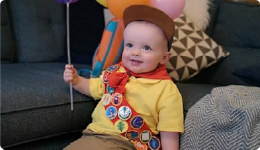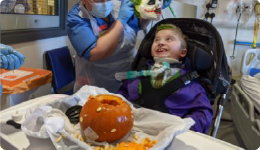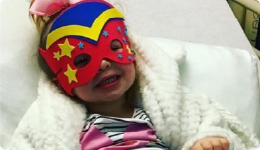Taking Part in Class Work

 Children learn through play and most schools focus on play in the early stages of primary school. As children move through school they take part in more formal learning activities. There are a number of skills children need to be able to do to take part in both play and more formal learning activities.
Children learn through play and most schools focus on play in the early stages of primary school. As children move through school they take part in more formal learning activities. There are a number of skills children need to be able to do to take part in both play and more formal learning activities.
Handwriting
Handwriting is part of our daily life – writing a birthday card, filling out a form, making a list. For children and young people writing is an 'occupation'. For children and young people over 5, it can be something they do most days. Handwriting is one way for a child/young person to express themselves. It can help with the flow of ideas. It shows they understand what is being taught and in schools handwriting is still the main way children/young people are tested and their progress reviewed.
Handwriting needs to be taught and develops over time. It is not just being able to hold and control a pencil. It is also:
- having the ideas of what you want to write
- having the words to express what you mean
- making a plan of how to organise your thoughts so that they make sense
- knowing how to make each letter to make up the words
- knowing how to spell words
- knowing how to put the words together to make sentences and paragraphs
- being able to read back what you have written to check it makes sense and is saying what you wanted it to say.
You need to be able to understand language and concentrate on the task. You need memory skills. You need to be able to hold a pencil/pen and control it to make the right movements to make the letters. All of these things have to come together to write.
Advice and Strategies
Getting Ready to Write
There are lots of resources to help children to Get Ready to Write on the Moving On to Primary School page.
Supporting those who find handwriting challenging
How you support a child/young person who is finding handwriting difficult depends on what they want and what they are finding most challenging. Think about your child/young person's goal - do they want their teacher to be able to read their writing or do they want to get their point across. This will help you to decide how best to meet that goal.
- Think about the task
- Make sure you give your child/young person time for the thinking/planning part of writing as well as the doing part of writing. Depending on what is difficult they might need more time for one or other part of the task.
- Focus on handwriting for activities that your child/young person enjoys or is motivated by for example writing a shopping list so that they/you can cook a favourite meal. The same applies in school, maybe they love science so they can write their science work but type or dictate their creative writing.
- Try different pencil/pens to find out what works best for your child/young person:

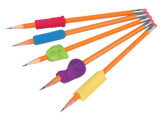 thick, thin, heavy, light, round, triangular pencil/pens
thick, thin, heavy, light, round, triangular pencil/pens- pencils/pens with/without finger rests
- pencils/pens with/without pencil grips
- 2B, HB or 2H pencils
- ball point pen, gel pen, felt tip pen, etc
- Try different types of paper:
- different textures
- different sizes
- different line spacing
- Think about your child/young person
- What will help them to feel successful? Are there other ways of demonstrating learning/getting a point across? Do you need to give extra time? Acknowledge effort and how hard they find writing. Emphasise their strengths. Make sure that everyone working with your child knows what they can do to help your child/young person. There is information on other ways to record learning below.
- Teach/try new strategies. There are lots of different strategies you can try - say it out loud, break the task down, check your work, ask questions, give clues, involve your child/young person in working out what works best for them.
- Think about the environment.
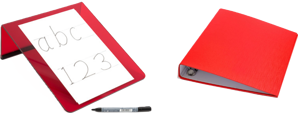 Think about reducing distractions.
Think about reducing distractions.- Think about furniture: Is it easier to write at a standing desk? Are the chair and table at the right height? Would an angled writing surface help?
- Think about space and position in the classroom. Do they need to be close to the teacher? Do they need to be at the end of a table? Would a checklist help with organisation?
Other ways to record learning
Since writing can be tiring and difficult for some children and young people even with lots of practice and other strategies put in place, using different ways of recording information can be helpful. Sometimes a mix of strategies might work. Encouraging your child/young person to use handwriting for some tasks and using other ways of recording for others, can reduce fatigue and increase confidence with getting thoughts on paper. Your child/young person could write for maths where there is less to write but use a different way of recording for creative writing. All strategies take time to learn and need practice to make them effective.
Other ways of recording learning to try:
 Speaking it out loud (and recording it) and having someone else write it down
Speaking it out loud (and recording it) and having someone else write it down- Using talk-to-text tools
- Having someone (who can read the writing) rewrite what was written to make it easier for others to read
- Draw instead of writing like in comics or graphic novels
- Typing it with or without using computer programmes to help.
It is important to start early to work out what works for your child/young person. Whatever strategy works for your child/young person having extra time is really useful too. This gives their hands and fingers time to rest but also means they have time to get their thoughts and ideas in order and have time to check what they have written too.
CALL Scotland are an organisation who have lots of information about supporting children/young people to record their work using technology to support them.
Information Technology (IT)
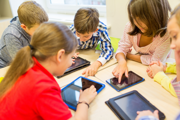 In schools and at home children and young people use lots of different types of technology as part of their learning and leisure time. They might use a smart phone, tablet, laptop or computer in school. They might play on a games consoles or use a smart phones/tablets to socialise with their friends. Technology can be used to support a child/young person who finds one or many areas of school work challenging for lots of different reasons.
In schools and at home children and young people use lots of different types of technology as part of their learning and leisure time. They might use a smart phone, tablet, laptop or computer in school. They might play on a games consoles or use a smart phones/tablets to socialise with their friends. Technology can be used to support a child/young person who finds one or many areas of school work challenging for lots of different reasons.
CALL Scotland are an organisation who have lots of information about supporting children/young people to use technology to support learning. They have information about what hardware might be helpful such as different keyboards, mice, screens or switches. They also have information about what software, apps or programmes might be helpful for different reasons and learning needs. They can help with finding different ways to record learning alongside handwriting or instead of writing.
Scissors
Children and young people will use scissors in primary school. Being able to use scissors effectively and safely can help children to demonstrate their learning.
Always supervise your child when they are using scissors.
Teaching Scissor Skills
Like handwriting we need to teach children how to use scissors to cut.
Choosing Scissors
- Child sized scissors are easier to hold
- Short blades are easier to control
- Rounded tips are safer
- Provide left handed scissors if needed
If your child finds standard child sized scissors difficult to use, they could try:
- Easi-Grip Scissors - the loop handle allows the scissors to automatically open when pressure is released.
- Long Loop Scissors - the longer loop allows the middle, ring and pinky fingers to be used to open/close the scissors, with the index finger being used to control on the outside.
- Spring Loaded Scissors - these scissors automatically re-open after each cut.
- Mounted Table Top Scissors - these scissors are self-opening with the spring automatically opening the scissors ready for the next cut. These scissors can be used one-handed. It is recommended that the stronger hand manipulates the position of the paper whilst the weaker hand operates the scissors.
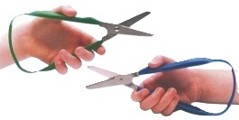
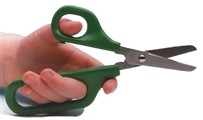
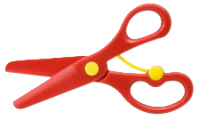
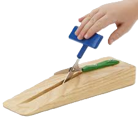
When purchasing any of the above items please shop around as prices may vary.
Materials to Cut
- A playdough sausage
- Straws (these can be threaded to make a necklace)
- Thin cardboard, 2cm wide strips
- Firm paper, 2-20cm wide strips
- Paper with a thick straight line to cut along (start with a 10cm wide strip of paper)
Scissor Safety
Teach rules about how to use scissors safely
- Make sure scissors are out of reach when not in use
- Teach them how to carry scissors with blades closed in their fist, handles up
- Make it clear what they can and cannot cut, like paper, card but not hair or clothes
- They need to be sitting down to cut
- Teach them how to hold the scissors and paper and to cut safely
- Don't point or wave scissors near other people
- Teach them to only use scissors when an adult is watching
How to Hold Scissors
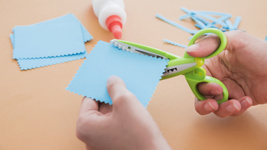 It is easiest to hold scissors in your doing hand with your thumb in the top loop and your index finger in the bottom loop. Teach your child to keep their thumb on top when cutting. Your child should hold the paper in their helping hand with their thumb on top and their other fingers curled underneath. It helps to keep your elbow close to your body when cutting. If your child is finding this tricky, get them to hold a beanbag or pair of socks between their elbow and their side when they are cutting. You could try marking the thumb hole with a piece of coloured tape so your child knows where to place their thumb.
It is easiest to hold scissors in your doing hand with your thumb in the top loop and your index finger in the bottom loop. Teach your child to keep their thumb on top when cutting. Your child should hold the paper in their helping hand with their thumb on top and their other fingers curled underneath. It helps to keep your elbow close to your body when cutting. If your child is finding this tricky, get them to hold a beanbag or pair of socks between their elbow and their side when they are cutting. You could try marking the thumb hole with a piece of coloured tape so your child knows where to place their thumb.
Using Scissors
- Get your child to practice opening and closing the scissors.
- Once they can open and close the scissors, teach them to snip (a snip is one cut). Start with playdough straws and strips of card (1cm wide).
- When they can snip, move onto wider strips until they are able to open and close the scissors while moving their cutting hand forward.
- Now practice using different materials, such as foil, thin card, cardboard, paper or playdough.
- Once the child is able to snip and cut card, move onto paper. Stick lolly sticks or straws on paper in straight lines and encourage your child to cut between sticks.
- Now draw a thick solid straight line for your child to cut along. As they improve, make the lines thinner.
- Teach them to move the paper with their helping hand while they are cutting instead of trying to turn the scissors.
- Now give them curvy lines, zigzags, squares, triangles and circles to cut.


